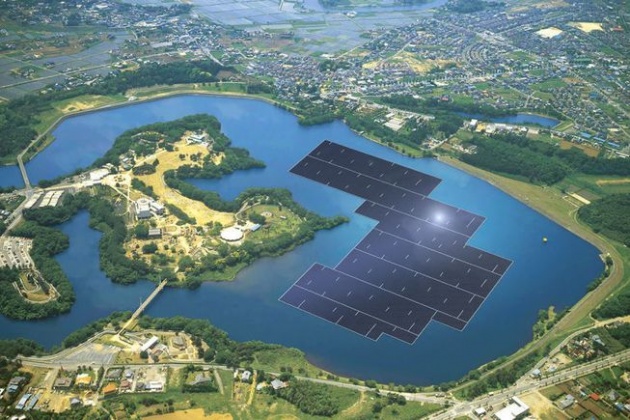In Japan, work kicks off on the world's largest floating solar farm
At a reservoir outside of Tokyo, water and electricity do indeed mix.

Traditionally, utility-scale solar farms that produce enough electricity to power hundreds, even thousands of households require land — and a whole lot of it.
However, in densely populated and topographically challenging countries where sprawling tracts of photovoltaic panel-ready land aren’t exactly a dime a dozen, you have to get creative and consider other options. And that includes bodies of water.
In perpetually ahead-of-the-curve Japan, a nation that’s big on solar but short on space, construction recently kicked off on what’s to be the world’s largest floating solar farm. Headed by a subsidiary of Kyocera, the Japanese electronics behemoth best known in North America for copy machines and ceramic cutlery, the 13.7-megawatt solar power plant will be located at the Yamakura Dam reservoir in Chiba Prefecture, outside of Tokyo. When all is said and done, there will be nearly 51,000 modular PV panels spread out across a “fresh water surface area” of 180,000 square meters (roughly 44 acres). With an estimated output of 16,170 megawatt-hours (MWh) per year, the facility will produce enough juice to power about 5,000 homes while offsetting 8,170 cubic tons of CO2 emissions annually — a figure that’s equivalent to the consumption of 19,000 barrels of oil.
Wow. Who said electricity and water don’t mix?
While the power plant at Yamakura Dam will be the largest such facility in the world, it’s not the first time that Kyocera has dipped its proverbial toes in the PV panel-filled water. The company has embarked on similar but smaller projects elsewhere in Japan including twin floating solar farms in Hyogo Prefecture with a combined annual output of 3,330 MWh.
Compared to their fixed brethren, floating solar farms are generally more expensive and significantly smaller in scale and output. But in Japan, a country where land not reserved for agricultural use is at a premium, taking full advantage of available space on lakes and reservoirs was born largely out of necessity.
Prior to 2011’s catastrophic Tohoku earthquake and tsunami, Japan sourced a sizable amount of its electricity needs from a network of nuclear power plants. Post-disaster, nuclear has played a minimal and, at times, nonexistent role in domestic electricity production. Currently, only one Japanese nuclear facility is in operation.
With nuclear largely out of the picture, Japan has embraced extreme energy conservation and aggressively moved toward homegrown renewable energy sources such as wind, geothermal and, of course, solar. Yet despite significant progress, Japan, just as it was prior to the 2011 tremor, remains hugely dependent on imported fossil fuels including coal, oil and natural gas. In fact, Japan is the second largest net importer of fossil fuels in the world.
This all said, the main obstacle in Japan’s unwavering quest to build up its renewable energy infrastructure is available land — or lack thereof.
Alongside the repurposing of abandoned golf courses, floating solar farms have proved to be one viable option. And although such installations, as mentioned, don’t (yet) boast the overall size/capacity of ground-mounted PV power plants, they do come equipped with some notable perks. For one, they're 11 percent more efficient when compared to ground-mounted installations of the same size thanks to the cooling effect of the water. The water, by the way, never comes in contact with the panels’ electrical components. The technology has proven to be incredibly safe — even earthquake-proof — when employed on inland bodies of waters.
The shade-providing floating panels also help to slow evaporation and stunt algae growth, making them a shoo-in for reservoirs in drought-stricken and/or agriculture-dependent regions.
While Japan is leading the floating solar farm revolution, other countries have got in on the action, including England, Brazil, Korea and Singapore. Australian company Infratech Industries recently exported its floating solar technology to Holtville, an agriculture-driven city (they don’t call it “Carrot Capital of the World” for nothing) in far southeast California near the Salton Sea. That 1 MW installation will power the city’s new water treatment plant while also staving off evaporation and improving overall water quality.
As for the floating solar farm at Yamakura Dam reservoir, it’s due to go online in the spring of 2018, provided that the construction timeline holds true. The power generated at the facility will be sold to Tokyo Electric Power Company (TEPCO), which, coincidentally, owns the decommissioned Fukushima Daiichi Nuclear Power Plant.



